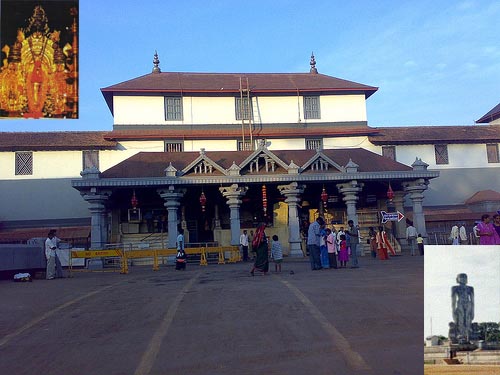|
|
Dhharmasthala Temple

Name of the Temple |
- Dhharmasthaḷa Manjunātha Swāmi Temple
|
Location |
- Dhharmasthaḷa is located in a village of the same name in the South Kanara District of Karṇāṭaka, South India.
|
| How to reach there? |
- By Air : Mangaḷūru airport is the nearest Airport, around 77 km away from Dhharmasthhaḷa. From the airport take the National Highway 73 east.
- By Train : The nearest railway station is located in Puttur, around 50 km away from Dhharmasthhaḷa. From Putthūr take the State Highway 113 north and than the National Highway 73 east.
- By Road : The Dhharmasthhaḷa Manjunāthha Temple is well connected by roads. It lies near the National Highway 73, 300 km from Bengalūru and 65 km from Mangaḷūru.
|
Rulers/builders and Time Period |
- 800 Years ago, Dhharmasthaḷa was known as Kuḍuma in Mallarmaḍi.
- It is believed that about 5 centuries ago a Jain family was blessed by the angels of Dhharmasthaḷa. Later, the Jain people made temples and installed the images of Dharma Dhaivas. This myth relates that to the bringing of the Śhiva Linga from Kadhri. Dharma Dhaivas sent a vassal, Aṇṇappa.
- The temple of Aṇṇappa faces the idol of Manjunātha in Dhharmasthaḷa. Around the 16th Century, Devarāja Heggaḍe invited Śhrī Vādhirāja Swāmi of Uḍupi to visit the place. The Swāmiji gladly came but refused to accept Bhikṣhā (food offering) because the idol of lord Manjunātha had not been consecrated according to Vedhic rites.
- Śhrī Heggaḍe then requested the Swāmiji to reconsecrate the Śhivalinga himself. Pleased by the observance of the Vedhic rites and Heggaḍe's charity to all, the Swāmiji named the place Dhharmasthaḷa, the abode of religion and charity.
- Thus, the roots of charity and religious tolerance established by the Pergaḍes 600 Years ago have been nurtured and strengthened by the Heggaḍe family, Heggaḍe being a derivative from Pergaḍe. And today's Dhharmasthaḷa blossoms with the fruit of this selfless dedication.
|
Deities’ - Goddess |
- The deities of the temple are Śhiva who is referred to as Manjunātha, Ammanavaru, Chandranātha and the Dharma Dhaivas (guardian spirits of Dharma) namely Kālarahu, Kalarkayi, Kumāraswāmi and Kanyākumari.
|
Architecture Style |
- The Jain influence can be seen in the 39 ft. statue of Bāhubali, erected in 1980 on the hill near the temple.
- Opposite the temple is the Manjūṣha Museum which houses a wide rage of objects, including ancient scripts on palm leaves, silver jewellery and religious statuary.
|
Other Special Features |
- Dhharmasthaḷa is situated on the banks of the river Nethrāvathi which is regarded as a sacred river by the devotees. The water of the Nethrāvathi river is used as the holy water for Dhharmasthaḷa.
- Thus the pilgrims who come to offer their prayers first bathe in this river to purify their soul before entering into the Manjunātha Temple, Dhharmasthaḷa. Dhharmasthaḷa Manjunātha temple is a temple dedicated to Lord Śhiva who is manifested in the form of lingam.
- Charity is a way of life here and pilgrims that throng the temple are given free food and lodging for three days
|
Any Other/Remarks |
- The word "Dharma" traditionally means religion, ritual, duty, righteousness, and alms. It also implies justice, truthfulness, freedom from fear, faith, solace, fulfillment and peace. Dhharmasthaḷa is the perfect embodiment of the word "Dharma" for it displays every shade of meaning with which the word is imbued. The greatness of Dhharmasthaḷa, however is the fact that it has added an active element to "Dharma", such that it touches the lives of people with a transformational directness that is unique.
- To those that come for worship, Dhharmasthaḷa represents religious tolerance wherein caste, creed and faith of pilgrims are no bars. For here, the Jain Thīrthankara is worshipped on the same consecrated grounds as the native Dhaiva and Lord Manjunātha. The priests are Vaiṣhṇavite Brahmins and the guardian of the temple is Heggaḍe, a Jain by faith. For precise understanding, the priests are Śhivaḷḷi Brahmins who belong to the Vaiṣhṇava sect of Hinduism and the administration is run by a Jain Bunt family called the Pergades.
- A grand Dīpothsava festival during November and December every year. The riot of colorful lightings is one of the important features of this festival. Dhharmasthaḷa Manjunātha temple has some interesting customs. It is among the first temples to have begun the mass wedding system in which the marriage rites are performed for hundreds of couples and all the expenses are taken care of by the temple.
- The temple feeds more than 10,000 people on an average everyday and no pilgrim is turned away. Nearby is a 39 ft monolithic statue of Gomateśhwara and a Mahamasthakābhiśheka is performed every 12 years.
- There are also a few Jain Basadhis, an indication of the co-existence of religions in this famous temple town.
|
Bibliography |
|
|
View Larger Map 



|
|















